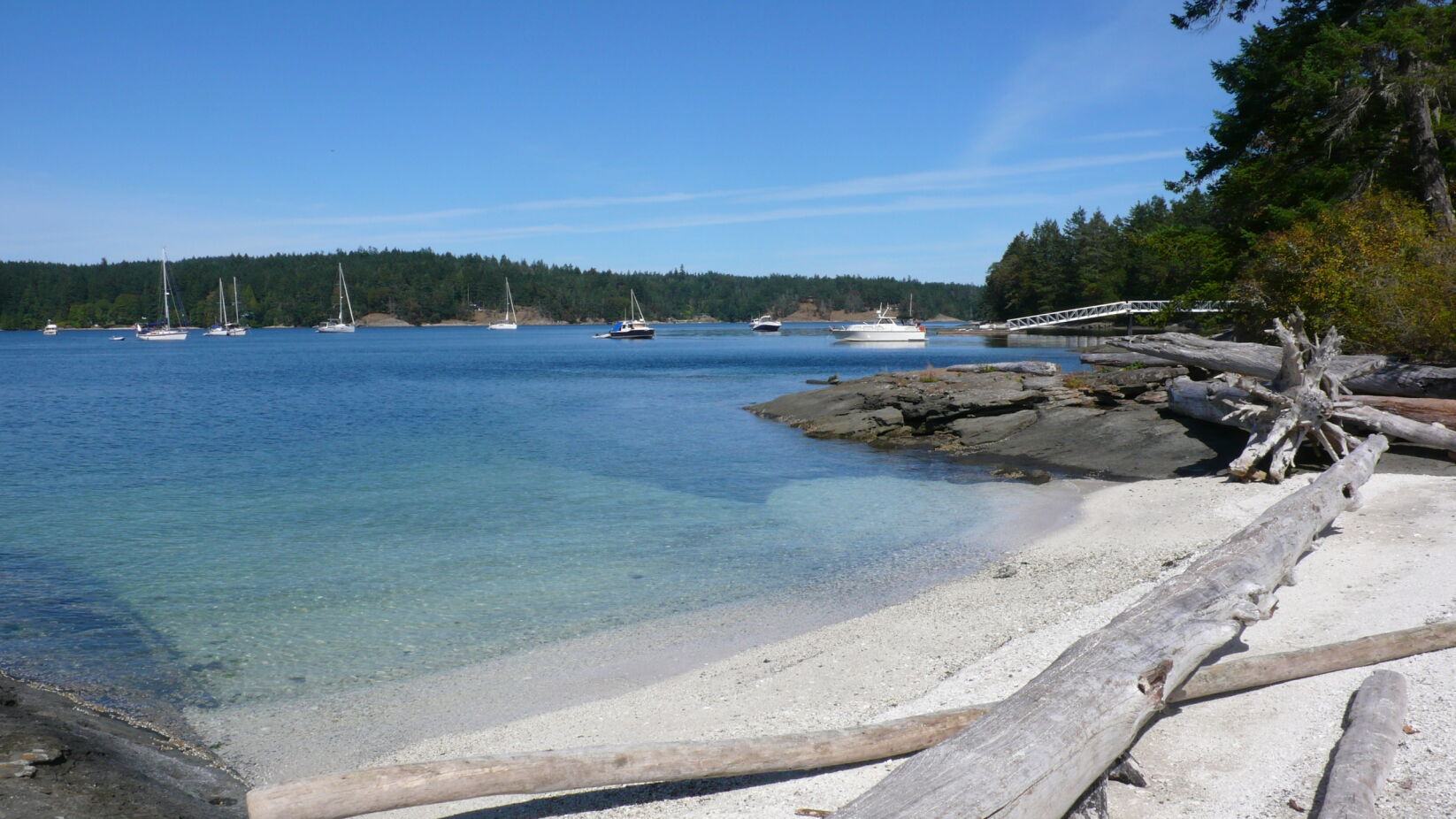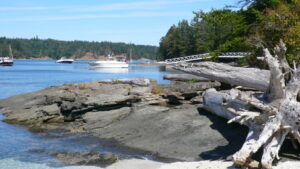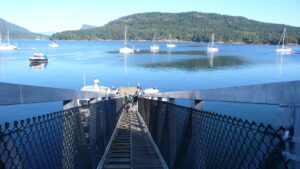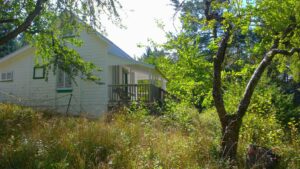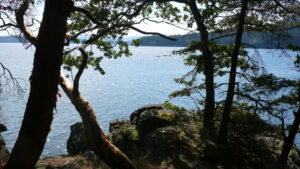“Can we anchor just off here?” I call back to the skipper from my location at Aquila’s bow. I love dropping the hook within view of that gorgeous white shell beach at Russell Island’s western end.
“Where else?” smiles the helmsman. “OK let her go. You’re in five fathoms.” Located at the entrance to Fulford Harbour on the southeast side of Salt Spring Island, this tiny island has been called a slice of Hawaii, partially for this tropical-looking white shell beach but primarily for its history of Kanaka occupation. (Kanaka means “human being” in the Hawaiian language.)
Although we have frequently anchored here over the years, we were thrilled when Russell became part of the Pacific Marine Heritage Legacy in 1997 and we could finally go ashore. We can sail here within an hour or two from our homeport on Pender Island, depending on the winds, and it’s one of our favourite day trips. This time we’ll spend the night here and go ashore to see if Russell has changed since our last visit. Anchoring here in five to 10 metres we have always found the holding ground secure over a gravel and kelp bottom and can snug our C&C 25 in quite close to the docks.
We’ll take the 15-minute trail that circles half of the island, check out the old homestead, enjoy that beautiful wee beach and then cool off in the emerald waters there—bracing but doable depending on how hot the day gets and how desperate I’ll be for a cool-off.
Rowing the short distance to the dinghy dock takes only a few minutes, and we’re greeted by some friendly Parks Canada staff, whose craft is moored on the park side of the dock. I ask them what’s happening with the park host program at the little homestead and find out that due to COVID-19 it didn’t happen in 2020, and that in 2019 the host program was not available because lead remediation work had been undertaken on the home. We head up that impressive ramp and turn right for our walk. WILL IT HAPPEN IN 2021?
Ivy Invasion One of the first things we always notice at Russell is the British countryside look to its forest. Ivy is everywhere: green and shiny, it’s ubiquitous, congregating on the ground in unruly mobs and rampaging up the evergreens in every part of the 13-hectare island park. Later, when I asked the superintendent of Gulf Islands National Park Reserve (GINPR), Marcia Morash, what the park policy was on removing exotic flora, she explained that the GINPR prioritizes invasive species management based on several factors such as the impact of these plants on ecological and cultural integrity, impacts on visitor experience and the feasibility of plant removal efforts. “We’re focusing on areas where we’ve found we can make more significant contributions to maintaining or restoring ecological heath.”
It was interesting to also learn that Parks Canada works with volunteers in many areas and islands of the reserve and that Russell Island represents a potential volunteer opportunity for this type of work in the future. We ask her to add our names to the volunteer list; I’d love to sink my hands into that ivy and yank.
Park Amenities Back in the early park days, at least two picnic tables were situated close to the shell beach but around 2013 they disappeared. We were sorry to see them go as they were ideally located for picnics, of which we had many. I took the opportunity to ask Morash what had happened to them and whether they would return: “There have not been picnic tables in that location in recent years,” she told us. “Gulf Islands National Park Reserve is not considering installing picnic tables on the point at this time as we focus on maintaining our current network of picnic tables and visitor experience infrastructure.” But they were part of a current network of picnic tables! They had certainly looked like park issue to us. Ah well, I suppose some might have felt they were a blight on the landscape, but we do miss those proper picnics with tablecloth and all the trimmings, surrounded by spectacular Gulf Island views.
The other nearby amenity, the outhouse, still stands and is well maintained. It’s near where the old Rohrer summer cottage used to be, but seeing as no traces now remain of that, I suppose that’s not too helpful. Just look for the path off the main trail and the familiar wooden profile.
The trail is very pleasant, with views over Swanson Channel to Vancouver Island and the Olympics beyond and the canopy is festooned with arbutus, Garry oak, firs, old-growth forest and low shrubs. The east side of the island is restricted and the trail circles back to join the path to the homestead or back to the docks.
Informative placards have also been added along the trail, giving visitors interesting details about the history, the flora, the people and the maps of Kanaka island settlements.
The GINPR demolished the Rohrer home and there is little sign now of where it used to stand, but certainly one of their most obvious and welcome changes was the removal of the old docks and ramp in April 2011 and their replacement with a very impressive 150-foot deluxe ramp with steel mesh siding and a sizeable dinghy dock.
Kanaka History and the Mahoi Homestead William Haumea, who arrived on Salt Spring around 1873 with his First Nations wife, Mary, pre-empted land southwest of Beaver Point and later acquired Russell Island as well, settling there in 1886. Although he never built a home on Russell, he was responsible for clearing fields and pasture areas as well as for establishing a large orchard and a strawberry field.
In 1901, Maria Mahoi was identified in his will as the sole heir to Russell Island. (She may possibly have been Haumea’s adopted daughter, although Morash says that any relation between William Haumea and Maria has not been documented.) With her second husband, George Fisher, and her seven children from her first marriage, she moved to Russell a year later, continuing to have six more children by Fisher. Only 570 square feet or 53 square metres, the tiny home was built on the northwest side of the island between 1902 and 1907 and a wharf in front of it was added. During this time the family also added considerably to the orchard, establishing a large vegetable garden and keeping sheep, chickens and even cows. Hard to believe that a family of 15 sustained themselves annually from this yield and also managed to sell some of their produce and seafood to obtain money for their other needs. Maria died in 1936 and one of her daughters, Mary Jane Fisher, preceded her on the island. She was Karey Litton’s grandmother, and his memory bank is full to the brim of when he, his two siblings and parents and sometimes even his cousins would visit in summers and Easter, the lot of them sleeping wherever they could in and out of this tiny homestead.
Russell remained in the family until 1959 when it was sold to the Rohrers from California, who initially stayed in the little homestead before constructing a summer home on the west side in 1972 with the intention of having a caretaker stay in the former, an arrangement that lasted until 1981. A year later, daughter Judith and her husband, Richard Anderson, moved to the summerhouse. Their plan was to live in the Mahoi house over the winter and for the next 10 years they made changes to the home, altering the floor plan of the first floor and stabilizing the second floor with beams. The Andersons sold the property to the Pacific Marine Heritage Legacy in 1997 and in 2003 it became part of Gulf Islands National Park Reserve. A placard at the trailhead by the dock thanks the Rohrer family for their land donation to Parks Canada.
In addition to the fruit trees and plants, there are several other items on the grounds worthy of a look. The wooden bench by the shore in front of the homestead was built by descendent Brad Logan in honour of his great-great-grandmother, Maria. The Hawaiian carving at the back of the house was created within the last 15 years, by a cousin, either Richard or Robert Butler, according to conversations conducted by Parks Canada with Litton. The tower behind the homestead was built in the early 1940s to pump water from the well to the tower, which once had a tank on the top. It was used for dishes and the toilet and provided cold water only. The Rohrers renovated it when they bought the property in the 1950s.
The old, rusted bicycle beside the house appears to have been left behind by the Rohrers, according to Litton. It’s a beauty.
If you take the trail on the right of the house, it leads to a sweet and private little beach.
Park Host Program The living history program that invited some of Mahoi’s descendants back to the island to act as volunteer hosts and greet summer visitors, that was instigated by Parks Canada in 2009, was inspirational. Litton was frequently one of them. We recall visiting during the summer several times when hosts would be in attendance and conduct talks and walks around the orchard. It was fun to see inside the tiny house and to hear the family stories and we hope it will be continued once COVID-19 fades into history. Through a volunteer agreement with the park reserve, the Mahoi descendants share these stories with visitors and answer questions about life on Russell Island. Their personal connection to the island adds a particular authenticity to the interpretation of the island’s history. “We appreciate all the volunteer time Mahoi family descendants have given to share with visitors their family’s life on Russell Island,” Morash agrees. Litton says he would be happy to return and once again re-live those halcyon times.
Prior to that program, a caretaking couple stayed at the home and we can recall meeting them as they took their child to school in Fulford Harbour in their little runabout.
Early First Nations Clam Gardens I had heard from Laura Judson, Public Relations and Communications Officer for GINPR, that sea garden restoration work was being carried out on Russell and I was curious to know more, and Morash very kindly filled us in with both the history of the clam gardens and the efforts to restore them. “For thousands of years, sea gardens have been an important shellfish management tool for First Nations along Canada’s West Coast. Coast Salish clam gardens often consist of a boulder wall built near the lowest tidemark, and a soft sediment terrace on the landward side. Recent scientific studies show that sea gardens produce four times as many butter clams and twice as many littleneck clams as unmodified beaches. A tended clam garden has many purposes: it is like a pantry of food, ready to be eaten when needed; it is also a classroom where Elders share knowledge and teach skills to youth.”
Since 2014, she told us, Parks Canada and Coast Salish youth, Elders, and knowledge holders have been making history by reviving traditional clam garden management practices that largely disappeared from the West Coast generations ago.
“There are many sea gardens in and around Gulf Islands National Park Reserve, but this project focuses on a select few, one of which is located on Russell Island.”
She points out that after six years of restoration effort, they are starting to see positive ecological responses. “It may take another five to 10 years before we have clear indicators that the health of shell populations is improving. From a social perspective the project has been a great success. The island has hosted large events involving students, cultural knowledge holders and scientists where everyone enjoys and learns from the sea gardens each spring.”
It’s 16:00. Time to head back to Aquila for happy hour. As always, our Russell rendezvous has been enjoyable and varied and we have even learned a few new things about an old friend.
[Sidebar]
Anchoring Ample anchoring is available at the island’s western end. The ferry wash from the Fulford Harbour ferry is seldom bothersome, holding ground is good and there’s protection from southerly winds. While a northwesterly could make it an uncomfortable anchorage, we have never been exposed to one in the summer.
Kanaka settlers in the Gulf Islands In the 1700s when the Northwest fur trade was thriving, Hawaiians often became employees of fur trade companies like the Hudson’s Bay Company and began to set up small establishments in the US and Canada. However, due to restrictions on citizenship south of the border, a number of Hawaiians moved to Canada’s west coast in the 1870s, settling on the Gulf Islands especially: Salt Spring, Russell, Coal and Portland Islands all bear traces. St. Paul’s church at the head of Salt Spring’s Fulford Harbour, built in 1883, contains many of the Kanaka graves including those of Maria Mahoi and her daughter Mary Jane Fisher.
Websites
Kanaka history: pc.gc.ca/en/pn-np/bc/gulf/culture/hawaienne-hawaiian.
Clam Garden restoration work and history: pc.gc.ca/en/pn-np/bc/gulf/nature/restauration-restoration/parcs-a-myes-clam-gardens
Want to volunteer with Parks Canada?
https://www.pc.gc.ca/en/agence agency/benevolat-volunteering
